This week we have a guest blog from Dr. Krisanadej Jaroensutasinee and Dr. Mullica Jaroensutasinee from the Centre of Excellence for Ecoinformatics at Walailak University in Thailand. The research they are presenting in this blog is also done with Dr. Siriwan Wongkoon, also from the Centre of Excellence for Ecoinformatics at Walailak University and Dr. Elena Sparrow with the International Arctic Research Center at the University of Alaska, Fairbanks.
Dengue is a serious public health problem in the tropical regions, particularly in Thailand. World Health Organization (WHO) estimated that about 50-100 million cases of dengue are recorded all over the world annually and two-fifths of the world population are at risk. More than one hundred countries have been affected by dengue or Dengue Hemorrhagic Fever/Dengue Shock Syndrome (DHF/DSS) epidemics. Indonesia, northern Australia, Central and South America, Southeast Asia, Sub-Saharan Africa, and some parts of the Caribbean have seen cases of this disease. Dengue fever is characterized by a sudden, high fever. A rash appears a few days after the fever has set in, and may also be accompanied by headaches, muscle and joint aches, and digestive upset.
In Thailand, dengue epidemics of increasing magnitude and severity occur every two to four years beyond the endemic levels. An endemic is when an infection is maintained within a certain population. Although dengue occurs throughout the year, cases peak from June to August, the wet season in Thailand. Neither a vaccine nor specific treatment for dengue fever is available. Vector control, which is the method in which mosquitoes are limited or eradicated, seems to be the most possible solution to prevent dengue transmission. Mosquito population dynamics are not the same in different geographical regions where dengue is transmitted suggesting that the influence of climate on dengue may be site specific.
As a mosquito-borne disease with a seasonal distribution, environmental factors, including weather variables, may play a significant role in the transmission of dengue. Temperature, rainfall, and relative humidity are major parameters influencing the incidence of dengue fever in Thailand. The prediction of global climate change and transmission of dengue and its geographic spread has been widely studied. Since dengue transmission is highly dependent on local environmental factors, it may not be possible to predict incidence outside locations with extensive valid data. However, investigations of local weather conditions and dengue incidence in different environmental and regional contexts can improve our understanding of the linkages between weather variables and dengue transmission, as well as provide strong scientific evidence for predicting future transmission patterns.
Monitoring of mosquito larvae, finding mosquito larval indices, and predicting dengue incidence can facilitate early warning and disease control and prevention. We developed Thailand mosquito protocol and the Mosquito Web Database System (MDS). The MDS provides an essential tool for querying, analyzing and visualizing patterns of mosquito larvae distribution in Thailand. MDS was developed using Structured Query Language (SQL) technology as a web-based tool for data entry and data access, webMathematica technology for data analysis and data visualization and Google Earth™ for Geographic Information System (GIS) visualization. The MDS prototype is available online at http://www.twibl.org/mosquito. The following images show screen captures of this web-based data entry system.
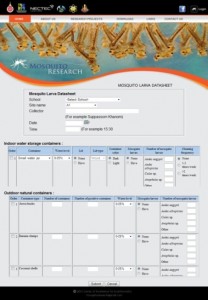
Data entry suite: mosquito larva datasheet containing data of mosquitoes in both indoor and outdoor water storage containers
As a mosquito-borne disease with a seasonal distribution, environmental factors, including weather variables, may play a significant role in the transmission of dengue. Temperature, rainfall, and relative humidity are major parameters influencing the incidence of dengue fever in Thailand. The prediction of global climate change and transmission of dengue and its geographic spread has been widely studied. Since dengue transmission is highly dependent on local environmental factors, it may not be possible to predict incidence outside locations with extensive valid data. However, investigations of local weather conditions and dengue incidence in different environmental and regional contexts can improve our understanding of the linkages between weather variables and dengue transmission, as well as provide strong scientific evidence for predicting future transmission patterns.
Twelve selected schools in Thailand provided test data for MDS. Users performed data entry using the web-service, data analysis and data visualization tools with webMathematica, data visualization with bar charts, larval indices, and three-dimensional (3D) bar charts overlaying on Google Earth™. The 3D bar charts of the number of mosquito larvae were displayed along with spatial information. These Google maps and mosquito larvae information should be useful to the dengue control and health service communities for their planning and operational activities. An example of the 3D bar chart is shown in the following image.
In addition to using 3D charts, the system also provides statistical information on mosquitoes as well as basic charts showing the number of mosquito larvae in indoor and outdoor containers.
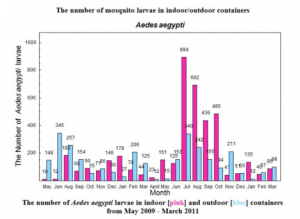
A screen capture of the graphic tool displaying the monthly mosquito larvae in indoor and outdoor containers
Are mosquitos a problem in your area? Have you done any research connecting atmospheric variables to mosquito populations? Send us an email at science@globe.gov or add a comment to let us know about your research!

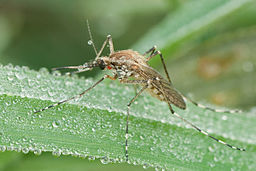
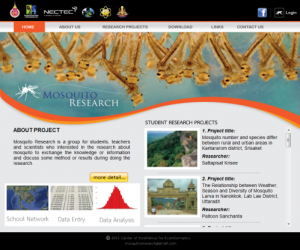
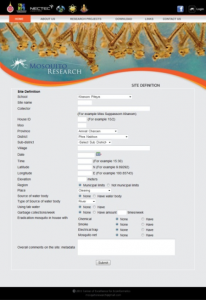
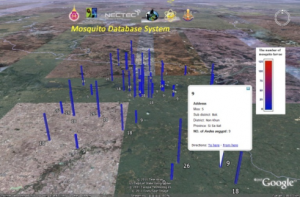
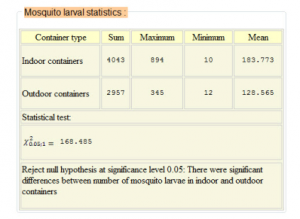
I live in a forested area so during the summer there are a lot of mosquitoes. Our city here uses “spray trucks” to spread pesticide and control the mosquito population but it doesn’t seem to help that much. Every time I go outside especially during the evening for a walk, I seem to get a few bites.
Hey, Tony.
I would love to hear more about mosquitos in your area. Do you know where are the possible breeding sites? What kind of mosquitos in your area? Do mosquitos live indoors or just only when you are outside the house?
Thanks for your post. Mullica
One of my friends had once Degue fiever and it is no fun. It is a hugh problem and we need to find a solution to it. Especially in Regions like Thailand.
This is the best blog and it is shared in a right time as dengue fever is spreading all over the world. Thanks to doctor Dr. Krisanadej Jaroensutasinee and Dr. Mullica Jaroensutasinee for spreading such a great knowledge all over the world with people.
Dengue is a serious public health problem in the tropical regions.Temperature, rainfall, and relative humidity are major parameters influencing the incidence of dengue fever.